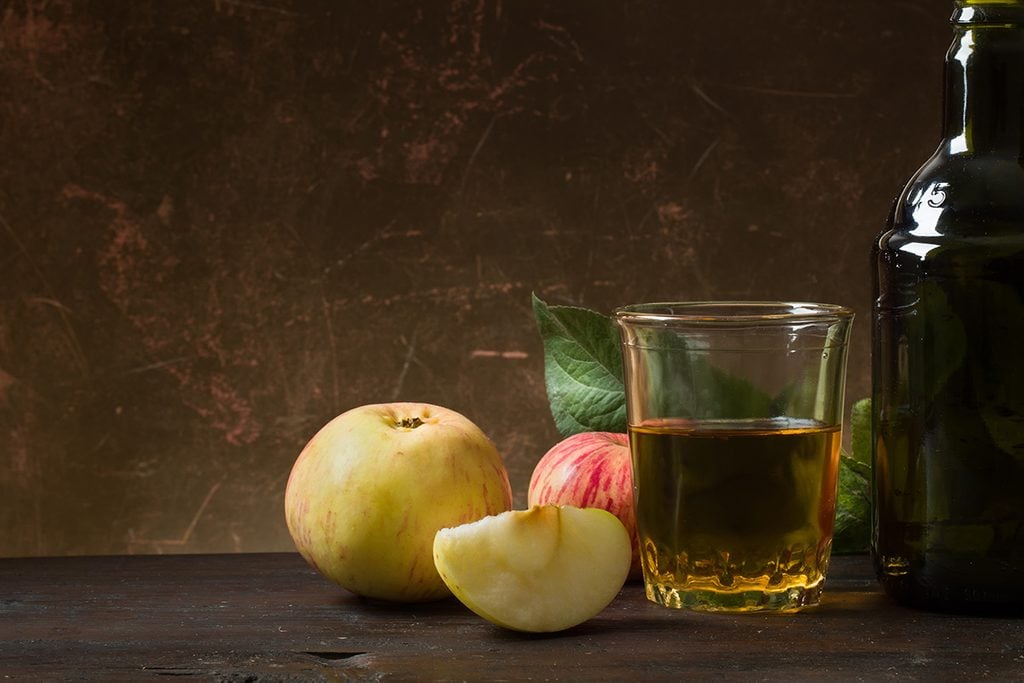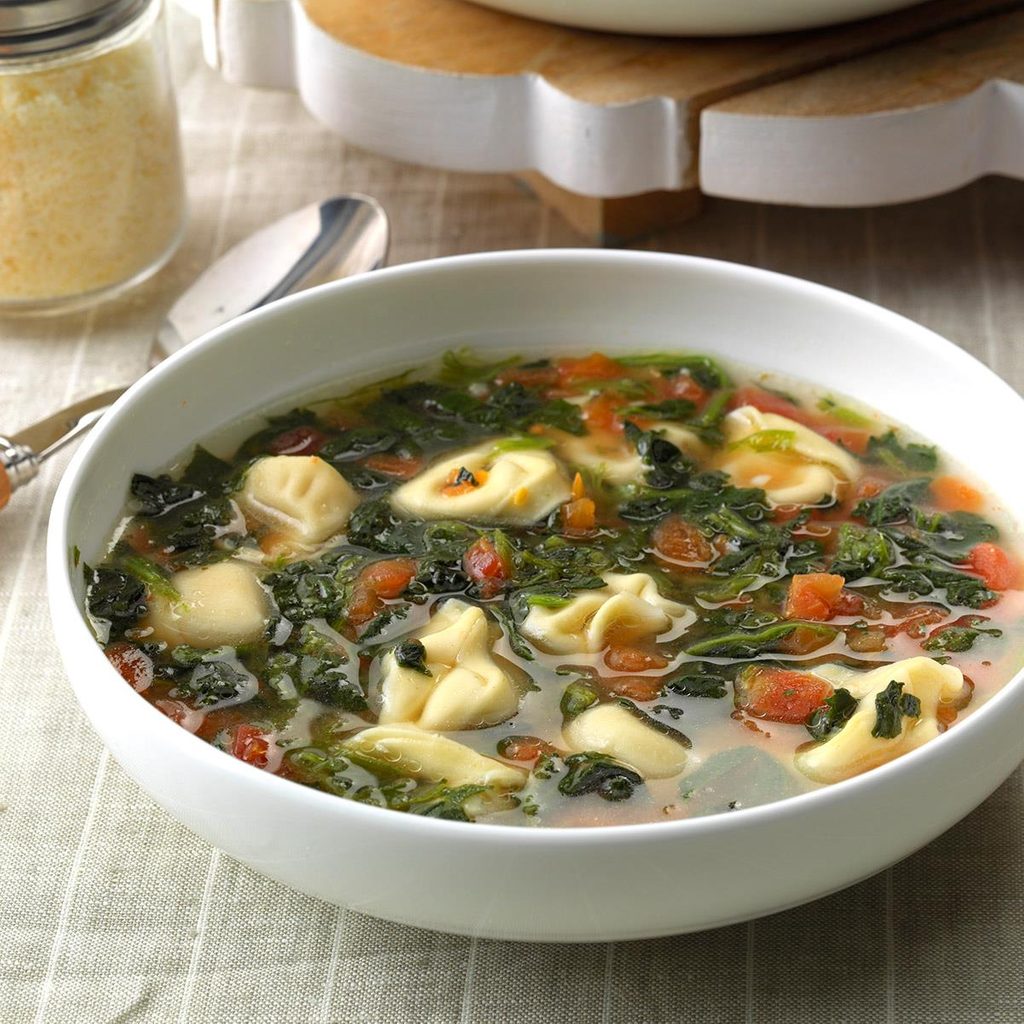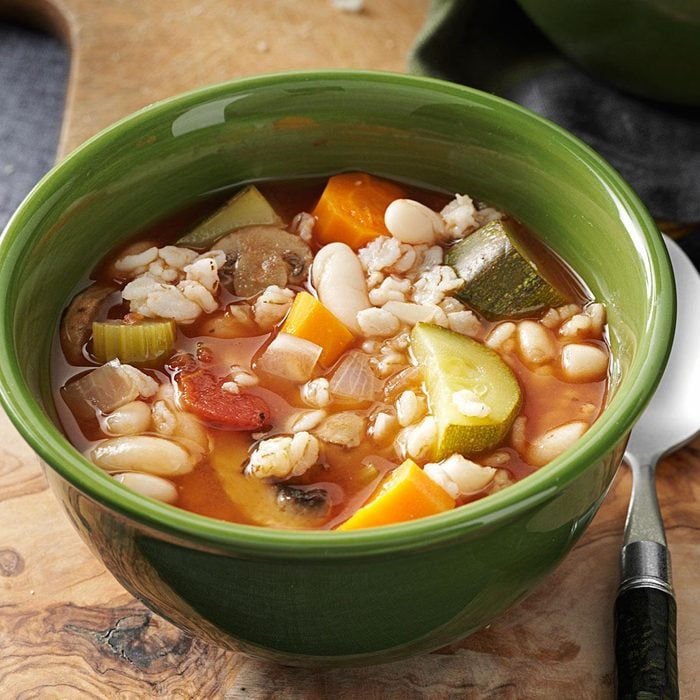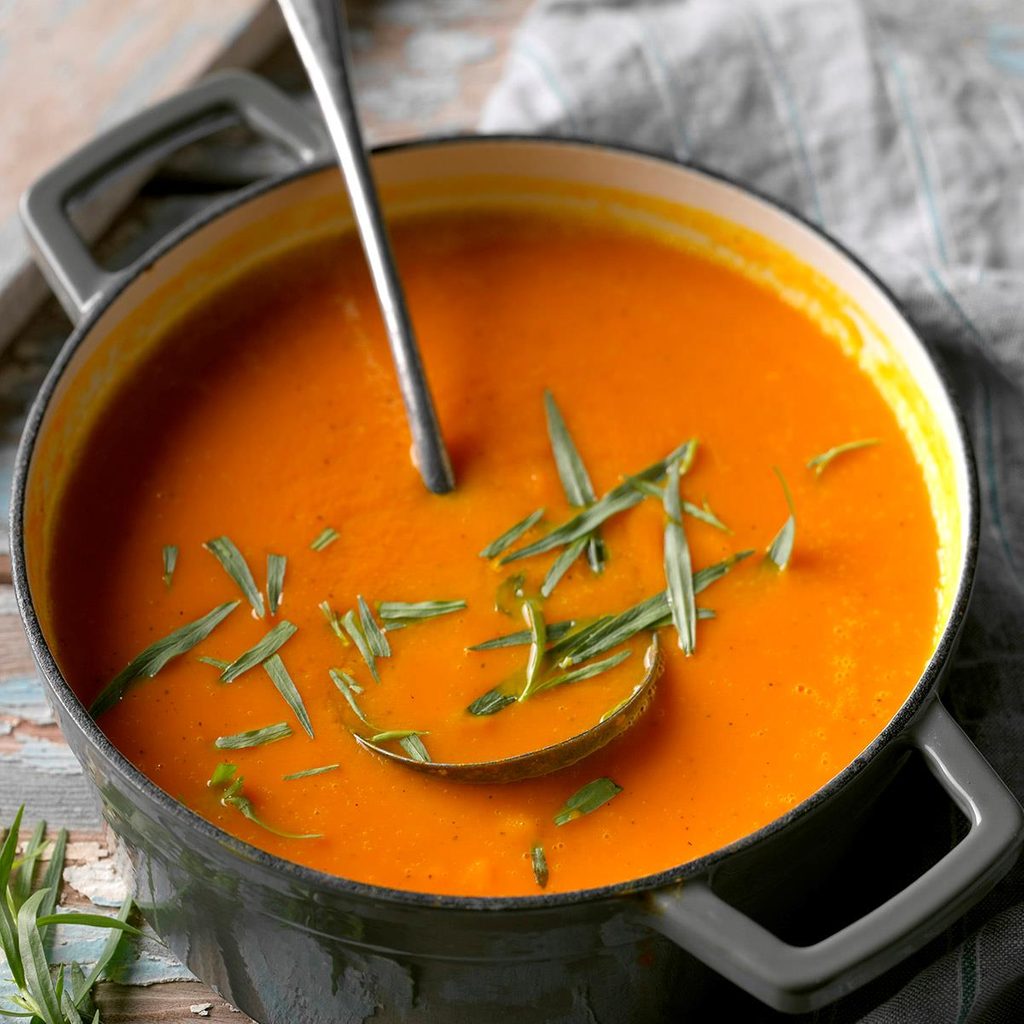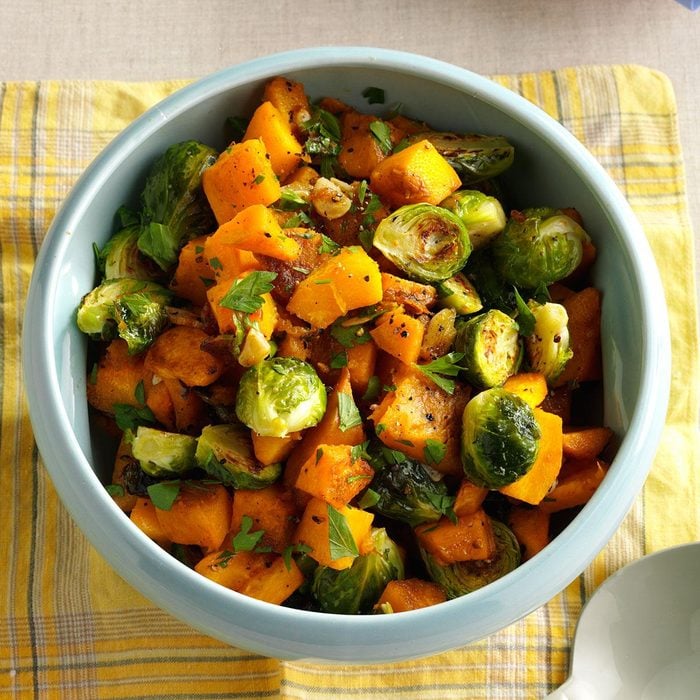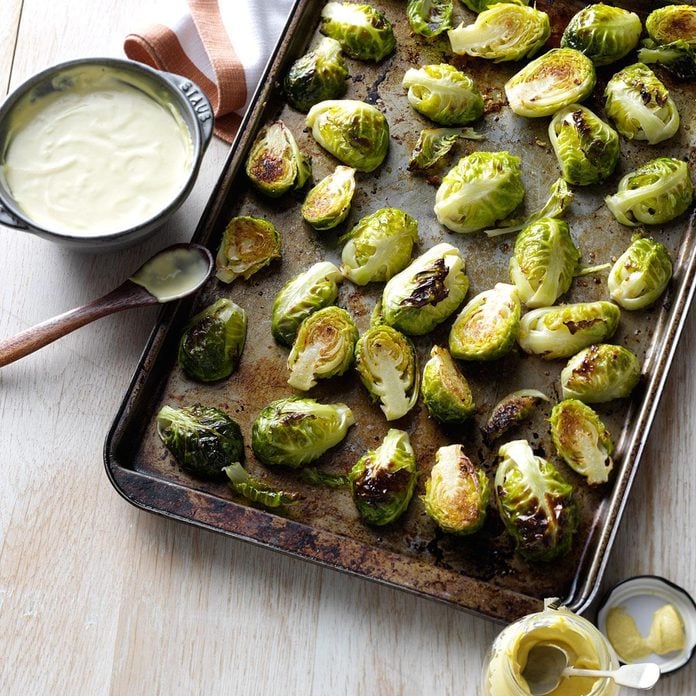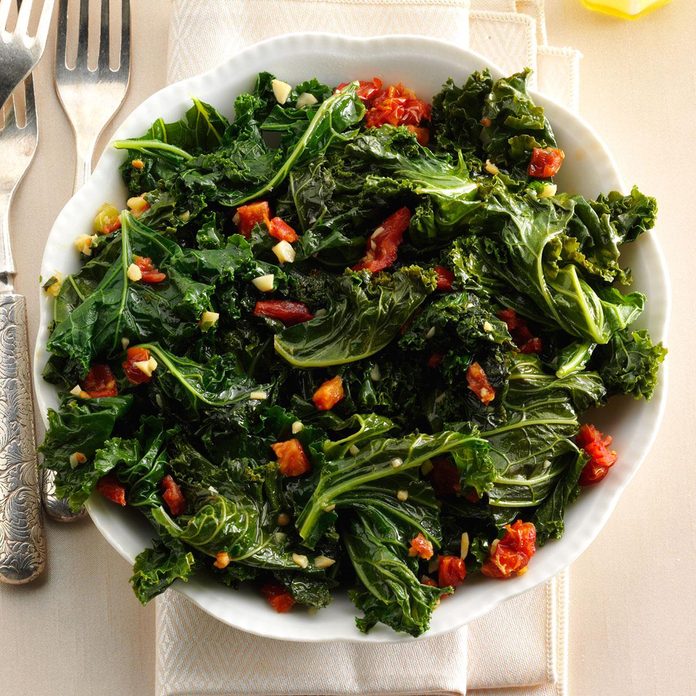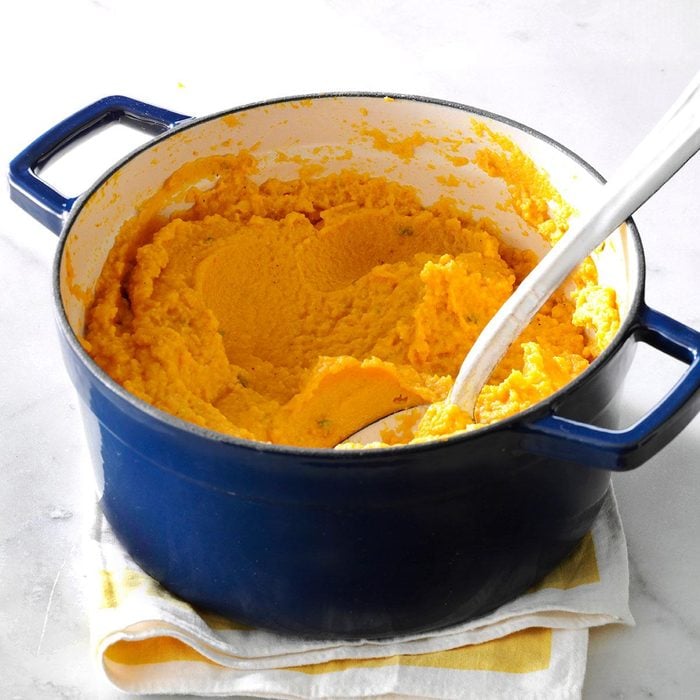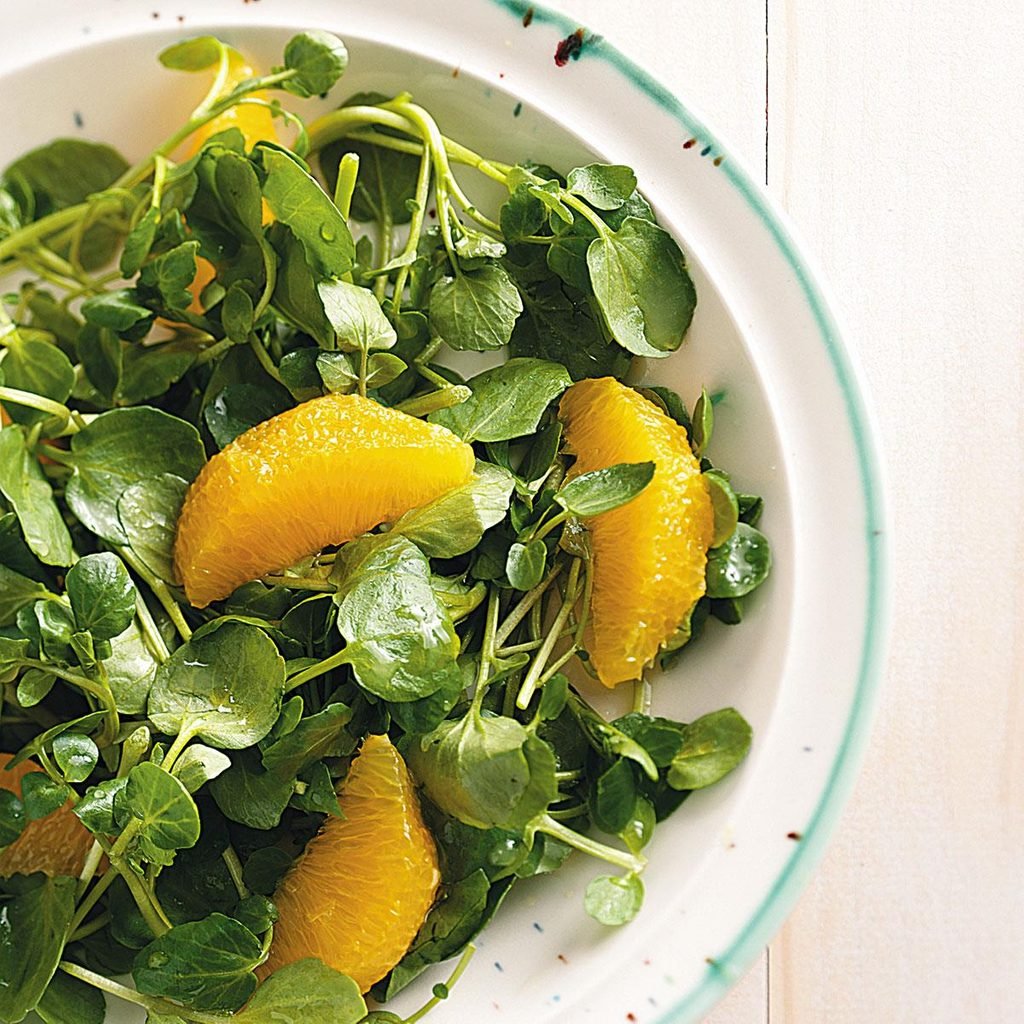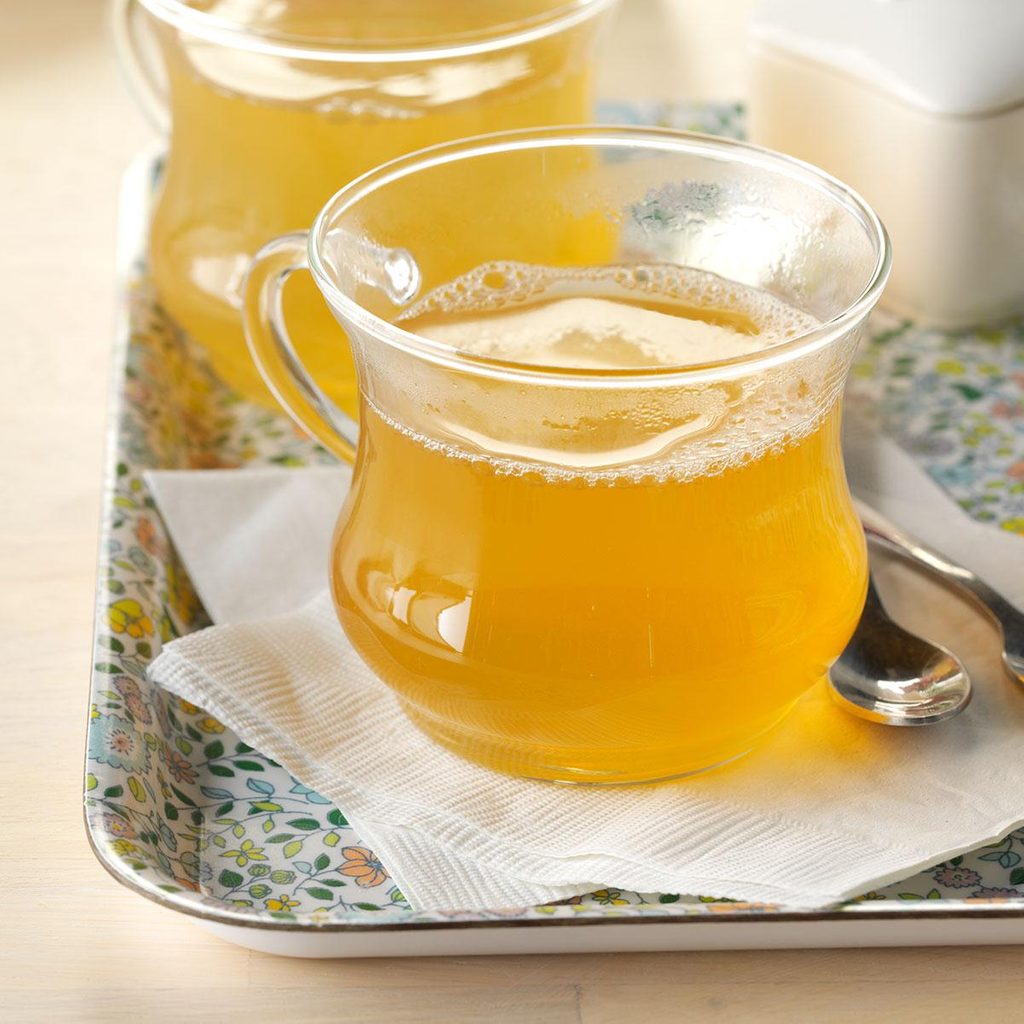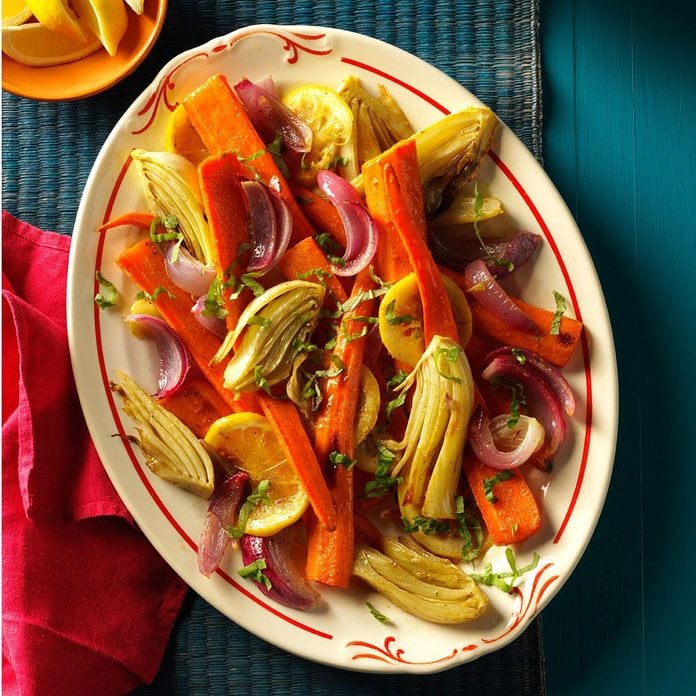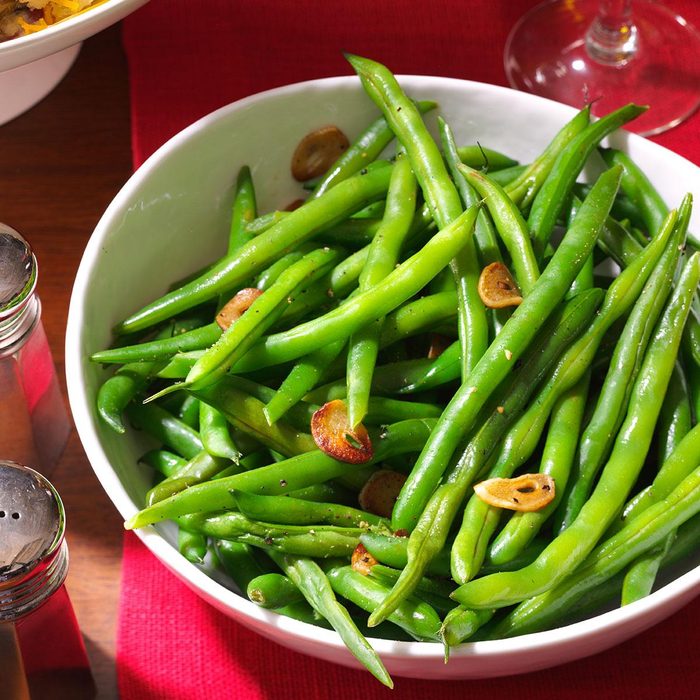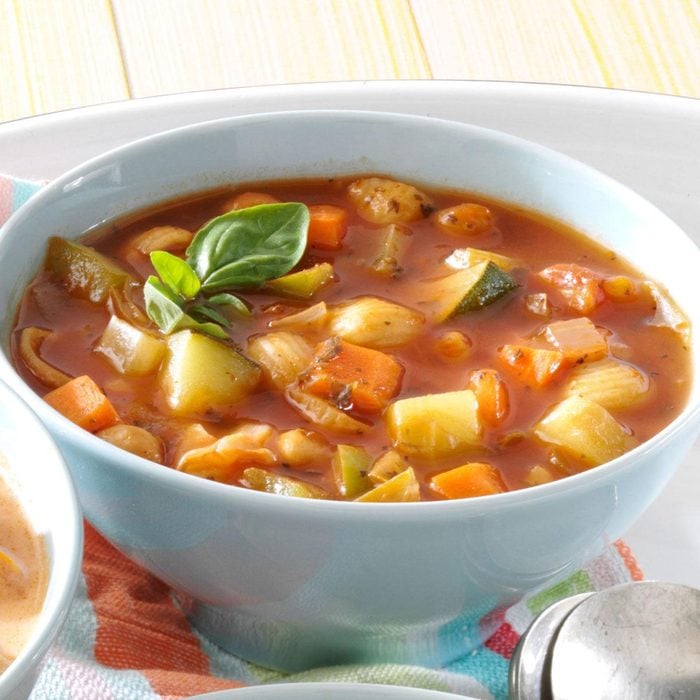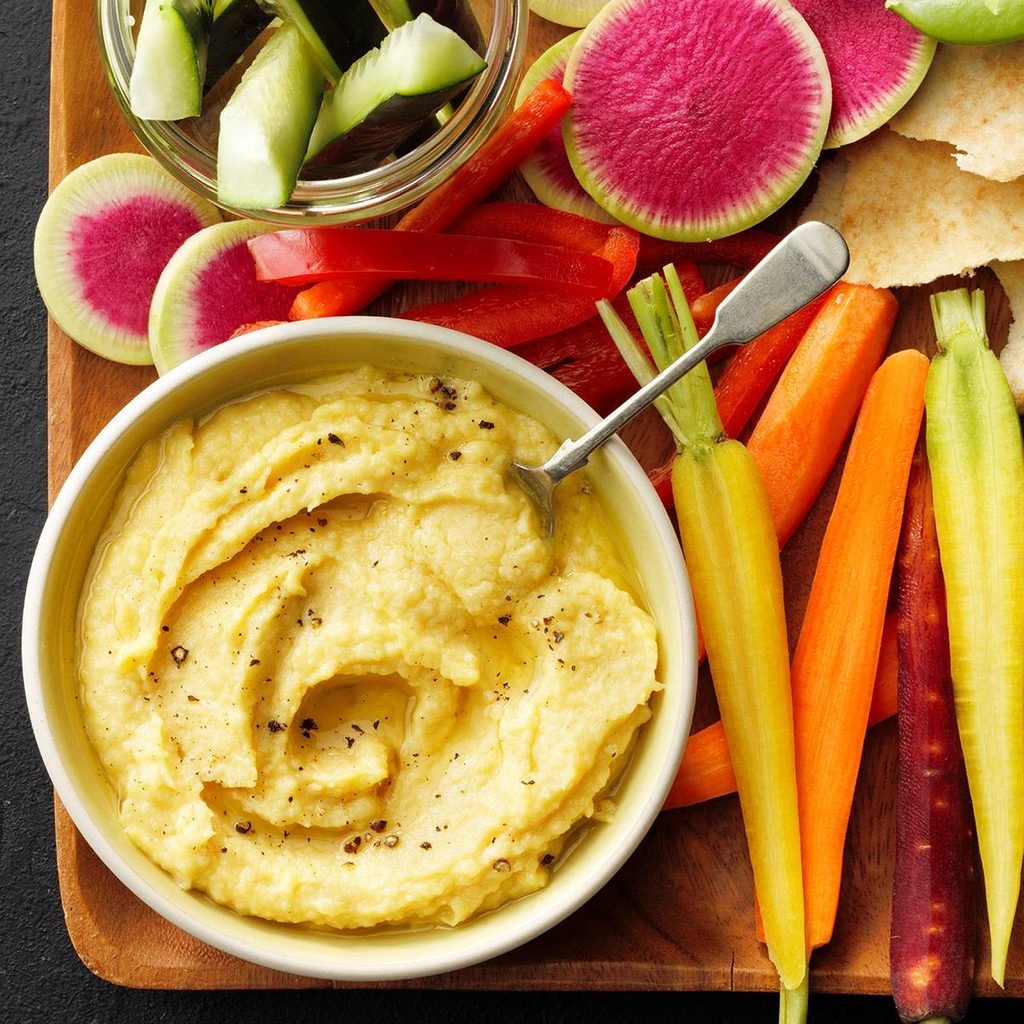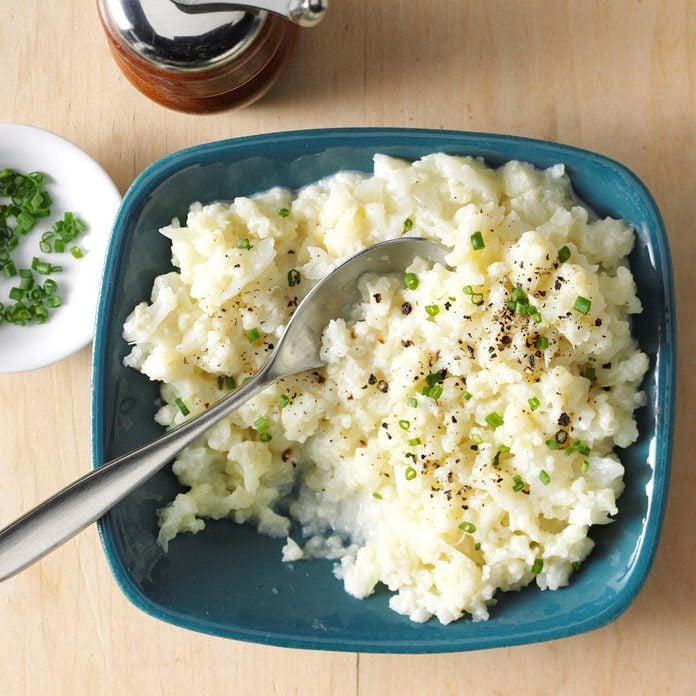We've got more cold-blasting foods right here.
Ultimate Chicken Noodle Soup
Nutrition Facts
1-1/3 cups: 239 calories, 12g fat (3g saturated fat), 68mg cholesterol, 1176mg sodium, 14g carbohydrate (3g sugars, 2g fiber), 18g protein.
You know that chicken soup is good for the soul, but it's also one of those foods that are good to eat when you have a cold. The medicinal benefits from the blend of celery, carrots and onions in a chicken broth can't be beat. If you want to reduce the sodium in this recipe, opt for a low-sodium chicken broth and add less salt into the pot as you cook. Find out
how much protein is there in the chicken.
Go to Recipe
Garlic Tortellini SoupNutrition Facts
1 cup: 189 calories, 6g fat (3g saturated fat), 23mg cholesterol, 1074mg sodium, 25g carbohydrate (2g sugars, 3g fiber), 11g protein.
Warm and comforting, this soup offers a powerhouse of aromatic cold-fighting goodness with garlic as well as vitamin C-rich spinach and tomatoes. Simple to make and even easier to eat when you have a cold, this soup is a soothing weeknight meal with a piece of crusty bread or fluffy dinner rolls.
Roasted Garlic Butternut SoupNutrition Facts
1 cup soup with 1 tablespoon blue cheese: 144 calories, 6g fat (3g saturated fat), 13mg cholesterol, 340mg sodium, 21g carbohydrate (6g sugars, 5g fiber), 4g protein. Diabetic Exchanges: 1 starch, 1 fat.
This hearty puree of garlicky sweet potatoes and butternut squash is a soothing anti-inflammatory blend of vitamins A and C as well as hydrating water and broth. It's easy to whip up this soup by roasting the veggies ahead of time and blending together later.
Slow & Easy MinestroneNutrition Facts
1-1/2 cups: 154 calories, 1g fat (0 saturated fat), 0 cholesterol, 1002mg sodium, 31g carbohydrate (8g sugars, 9g fiber), 7g protein.
Full of hydrating vegetables loaded with plant compounds and vitamins, this sick day soup couldn't be easier. All you need to do is set it and forget it in the slow cooker. Cook it while you nap and wake up to nourishing food to eat when you have a cold.
Citrus Melon MingleNutrition Facts
3/4 cup: 125 calories, 0 fat (0 saturated fat), 0 cholesterol, 11mg sodium, 31g carbohydrate (25g sugars, 3g fiber), 2g protein. Diabetic Exchanges: 2 fruit.
Bright and fresh, this fruit salad is the perfect food to eat when you have a cold. Packed with immune supporting vitamin C from the oranges, melon and grapefruit, as well as hints of fresh ginger to ease digestion, this salad is a simple healing dish to power your total body wellness.
Carrot Soup with Orange & TarragonNutrition Facts
1 cup: 117 calories, 3g fat (2g saturated fat), 8mg cholesterol, 823mg sodium, 18g carbohydrate (10g sugars, 4g fiber), 4g protein.
Creamy and nourishing, this soup is super simple and packed with vital antioxidants. Plus, the recipe calls for a hint of tarragon, an herb that contains manganese. This mineral can help decrease damaging stress to your cells.
Rosemary Roasted Baby CarrotsNutrition Facts
3/4 cup: 82 calories, 4g fat (0 saturated fat), 0 cholesterol, 238mg sodium, 12g carbohydrate (8g sugars, 2g fiber), 1g protein. Diabetic Exchanges: 2 vegetable, 1/2 fat.
Tossed with olive oil, rosemary, cumin and black pepper, these carotenoid-rich carrots are loaded with intense flavor. The best part is you don't have to tend to them as they roast in the oven. Simply set a timer and rest.
Roasted Pumpkin and Brussels SproutsNutrition Facts
3/4 cup: 152 calories, 9g fat (1g saturated fat), 0 cholesterol, 255mg sodium, 17g carbohydrate (4g sugars, 3g fiber), 4g protein. Diabetic Exchanges: 2 fat, 1 starch.
Try this savory and colorful immune-supporting combo of pumpkin and Brussels sprouts. The garlic, olive oil and balsamic vinegar amp up the feel-good flavors in this dish, but you can add extra sweetness with dried cranberries. Bonus, dried cranberries are also an excellent source of antioxidants too.
Cumin-Roasted CarrotsNutrition Facts
1 serving: 86 calories, 4g fat (3g saturated fat), 0 cholesterol, 277mg sodium, 13g carbohydrate (5g sugars, 4g fiber), 1g protein. Diabetic Exchanges: 1 vegetable, 1 fat.
There's nothing like warm spices to make you feel better when you have a cold. Try these cumin, coriander and garlic dressed carrots to excite your senses and soothe your breathing passages. Toast the aromatic spices in a skillet to enhance the overall flavor experience.
Garlic-Roasted Brussels Sprouts with Mustard SauceNutrition Facts
3/4 cup: 167 calories, 12g fat (5g saturated fat), 27mg cholesterol, 241mg sodium, 13g carbohydrate (3g sugars, 4g fiber), 4g protein.
There are many
health benefits of Brussels sprouts, and adding them to your menu during a sick week can help your body get up to speed more quickly. The carmelized flavor that results from roasting along with the Dijon mustard for dipping will put a pep in your step and immune system.
Warm Tasty Greens with GarlicNutrition Facts
2/3 cup: 137 calories, 9g fat (1g saturated fat), 0 cholesterol, 216mg sodium, 14g carbohydrate (0 sugars, 3g fiber), 4g protein. Diabetic Exchanges: 2 vegetable, 2 fat.
Kale is packed with vitamins A and C, which are two powerful nutrients in decreasing the severity of the common cold. If you'd rather not boil the kale in this recipe, you can saute it with plenty of olive oil. Sauteeing can also help keep some of the crisp structure of this leafy green vegetable.
Fennel Carrot SoupNutrition Facts
1 cup: 117 calories, 2g fat (1g saturated fat), 4mg cholesterol, 989mg sodium, 23g carbohydrate (0 sugars, 3g fiber), 3g protein. Diabetic Exchanges: 2 vegetable, 1 starch.
This blend of plant foods from sweet potatoes, apples, carrots and fennel is a powerhouse in a bowl. Plus, it's seasoned with
curry powder, an anti-inflammatory spice blend that can soothe you when you're fighting a cold.
Pumpkin & Cauliflower Garlic MashNutrition Facts
2/3 cup: 87 calories, 4g fat (2g saturated fat), 9mg cholesterol, 482mg sodium, 12g carbohydrate (5g sugars, 4g fiber), 4g protein. Diabetic Exchanges: 1 vegetable, 1/2 starch, 1/2 fat.
Garlic, pumpkin and cauliflower, oh my! This mash-up is perfect for curing whatever ails you. Tasty as a side dish for grilled chicken or fish, this vibrantly colored puree offers the best defense when you most need it.
Chicken & Garlic with Fresh HerbsNutrition Facts
1 chicken thigh with 2 tablespoons cooking juices: 203 calories, 11g fat (3g saturated fat), 76mg cholesterol, 346mg sodium, 2g carbohydrate (0 sugars, 0 fiber), 22g protein. Diabetic Exchanges: 3 lean meat, 1/2 fat.
This
one-pot meal couldn't be easier to make when you're having a sick day. Adding high quality protein to your diet gives your muscles the energy you need to get through the day. Plus, the aromatic garlic, rosemary and thyme enhances the flavor and immune-boosting impact of this cozy dish.
Watercress & Orange SaladNutrition Facts
3/4 cup: 58 calories, 5g fat (1g saturated fat), 0 cholesterol, 37mg sodium, 4g carbohydrate (3g sugars, 0 fiber), 1g protein. Diabetic Exchanges: 1 vegetable, 1 fat.
Watercress is an excellent superfood green that is fun to use in place of other greens like spinach or kale. With a double punch of vitamin C from the peppery watercress and zesty oranges, this plant-powered dish can boost your immunity, as well as your spirits.
Lemon Thyme Green TeaNutrition Facts
1 cup: 33 calories, 0 fat (0 saturated fat), 0 cholesterol, 0 sodium, 9g carbohydrate (9g sugars, 0 fiber), 0 protein.
Sick days call for vitamin C, a water soluble vitamin that boosts immune health and can decrease the severity of a cold. This lemon tea is sure to soothe a sore throat and any aches and pains you have. Plus, it steeps in minutes, making it a simple elixir to help you feel better.
Roasted Carrots & FennelNutrition Facts
1 serving: 139 calories, 7g fat (1g saturated fat), 0 cholesterol, 262mg sodium, 18g carbohydrate (9g sugars, 6g fiber), 2g protein. Diabetic Exchanges: 2 vegetable, 1-1/2 fat.
Fennel, a licorice-flavored herb is jam-packed with antioxidants and anti-inflammatory compounds that boost cell health. In addition, you get a healthy dose of vitamin C, calcium, iron, magnesium, potassium and manganese, which all come in handy when fighting a cold.
Herb Roasted Root VegetablesNutrition Facts
3/4 cup: 130 calories, 4g fat (1g saturated fat), 0 cholesterol, 263mg sodium, 22g carbohydrate (5g sugars, 4g fiber), 3g protein. Diabetic Exchanges: 1-1/2 starch, 1 fat.
You can't go wrong with
fresh root vegetables to remedy a cold. This dish is loaded with immune-supportive vitamin C and potassium from the mix of white and sweet potatoes, carrots, parsnips and turnips. The high fiber also keeps the healthy bacteria teeming in your tummy.
Orange Poppy Seed SaladIt's easy to throw together this salad when you have a cold, plus you know you're doing your body good. Packed with vitamin C from the oranges, fiber and omega-3 fats from walnuts and antioxidants from the pomegranate seeds, your immune system will get the nutritional support it desperately needs. If you make the dressing with raw apple cider vinegar, you'll get an added probiotic boost too!
Fresh Green Beans & GarlicNutrition Facts
1 serving: 91 calories, 6g fat (2g saturated fat), 8mg cholesterol, 245mg sodium, 8g carbohydrate (3g sugars, 3g fiber), 2g protein. Diabetic Exchanges: 1-1/2 fat, 1 vegetable.
If you notice digestive issues when you have a cold, it could be because of the stress on the cells in your body. To promote healthy cell turnover and to give your body the immune support it requires to heal, try this green bean dish. It's also rich with garlic, which will give you a great antimicrobial boost.
Hearty Meatless MinestroneNutrition Facts
1-1/2 cups: 191 calories, 6g fat (1g saturated fat), 0 cholesterol, 664mg sodium, 29g carbohydrate (9g sugars, 7g fiber), 6g protein. Diabetic Exchanges: 3 vegetable, 1 starch, 1 fat.
There are lots of
healthy vegetarian meals out there, and this meatless minestrone is one of our favorites. The plant-based soup offers your body a powerhouse of healing nutrients from the plant compounds in the vegetables and herbs. Plus, you'll have plenty to eat throughout the week, which means less cook time when you're sick!
Simple Tomato SoupNutrition Facts
1 cup (calculated without cheese): 120 calories, 7g fat (4g saturated fat), 19mg cholesterol, 1270mg sodium, 13g carbohydrate (6g sugars, 1g fiber), 3g protein.
Who doesn't love tomato soup when you have a cold? This soup is loaded with lycopene, a powerful antioxidant packed into tomatoes—which is especially high in cooked canned tomatoes. If you need a comfort food classic to pair with this tomato soup, try a
gooey grilled cheese sandwich.
Lemon-Garlic HummusNutrition Facts
1/4 cup: 324 calories, 29g fat (3g saturated fat), 0 cholesterol, 309mg sodium, 14g carbohydrate (2g sugars, 3g fiber), 3g protein.
Smooth and creamy and loaded with intense aroma and flavor, this hummus is a simple way to get in plant-based protein and fiber-filled carbs. On those days when you are craving simple nourishing foods, this lemony vitamin C-rich chickpea spread will save the day. Dip your favorite vegetables in the lemon-garlic hummus or use it as a base in
hummus recipes.
Garlic Mashed CauliflowerNutrition Facts
1/2 cup: 74 calories, 4g fat (1g saturated fat), 4mg cholesterol, 428mg sodium, 8g carbohydrate (4g sugars, 3g fiber), 3g protein. Diabetic Exchanges: 1 vegetable, 1 fat.
Cauliflower, the ultimate cruciferous veggie, is the star in this dish. It's one of those
foods that are high in vitamin C, and it's also super simple to whip together on a sick day. To add more gut-friendly bacteria, use a dollop of plain yogurt instead of mayo.
Warm Spiced ChaiNutrition Facts
1 cup: 102 calories, 3g fat (2g saturated fat), 8mg cholesterol, 44mg sodium, 17g carbohydrate (16g sugars, 0 fiber), 3g protein.
If you're feeling too under the weather for food, sometimes just a comforting drink will help. This homemade
chai tea is loaded with good-for-you aromatic spices, such as cardamom, cinnamon, ginger, star anise and cloves. Many of these spices have anti-inflammatory properties, which may help your body fend off common cold culprits.
